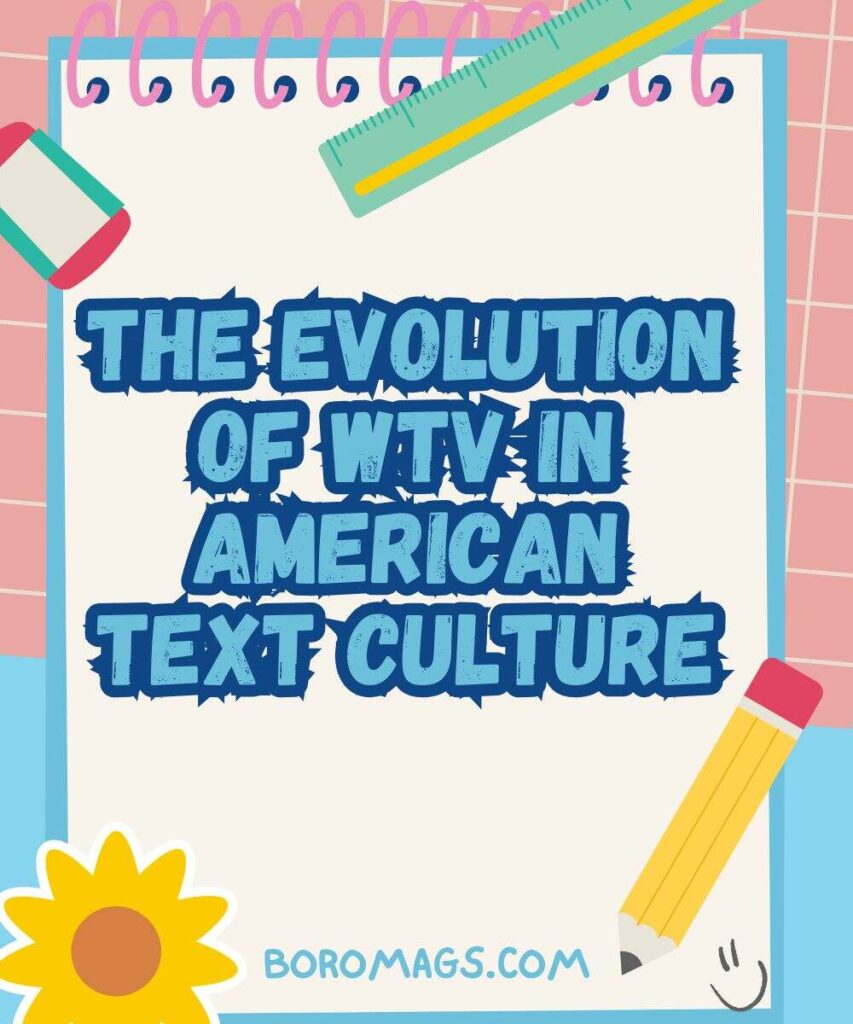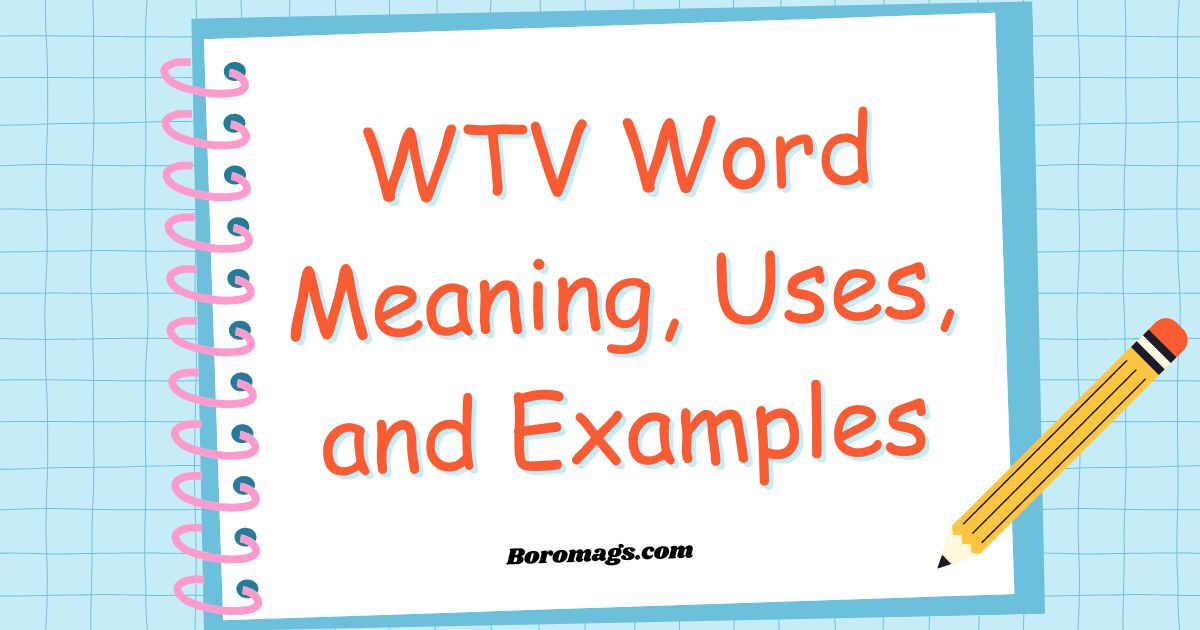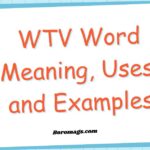In today’s rapidly evolving world of digital communication, understanding text slang and online expressions has become essential. Among the countless abbreviations that populate our text-based communication, WTV stands out as a versatile and widely used term.
Digital shorthand has revolutionized how we communicate, making expressions like WTV integral to our daily conversations. Whether you’re new to internet slang or looking to enhance your understanding of casual language, this guide will help you navigate the nuances of WTV usage.
What is WTV: Breaking Down the Modern Text Slang
At its core, WTV is the abbreviated form of “whatever” in text messaging and online chatting. This shortened communication form emerged as part of the broader evolution of internet culture and the need for language efficiency in fast-paced conversations.
The term represents more than just a simple shorthand—it’s a reflection of how linguistic evolution adapts to modern communication needs. In the context of American text culture, WTV has become a staple of casual digital discourse.
More Post: GTS Word Meaning: Definition, Uses & Examples
The Evolution of WTV in American Text Culture

The journey of WTV from a simple abbreviation to a widely recognized piece of social media language showcases the dynamic nature of modern communication. This evolution has been particularly notable in:
- Text messaging platforms
- Social media conversations
- Online chat rooms
- Instant messaging applications
What Does WTV Mean?
As a prime example of informal writing, WTV serves multiple purposes in conversation:
- Primary Meaning: Direct abbreviation of “whatever“
- Contextual Usage: Expression of indifference
- Emotional Subtext: Casual dismissal or acceptance
- Communication Style: Indicator of informal tone
Using WTV in a Sentence
To better understand how WTV functions in text-based communication, consider these authentic examples:
In Group Chats:
Friend 1: Should we meet at 6 or 7?
Friend 2: WTV works for me!
In Personal Messages:
Person A: Pizza or burgers tonight?
Person B: WTV, you choose!
Additional everyday texting examples showing how WTV is used:
Making Plans:
Sarah: Want to go to the mall or the movies?
Mike: WTV, I’m fine with either!
Deciding on Food:
Mom: Should I cook pasta or rice for dinner?
Me: WTV sounds good to me!
Meeting Time:
Jake: Is 3pm or 4pm better?
Lisa: WTV, I’m free all afternoon!
Why Do People Use WTV?
The popularity of WTV in digital communication stems from several key factors:
- Efficiency: Saves time in fast-paced conversations
- Casualness: Creates a relaxed atmosphere
- Universality: Widely understood across age groups
- Versatility: Applies to various situations
Using WTV in Everyday Conversations
The practical application of WTV varies across different conversational tones and contexts:
| Context | Example Usage | Appropriateness Level |
| Friends | “WTV works!” | High |
| Family | “WTV, you pick” | Moderate |
| Work | Not recommended | Low |
| Social Media | “WTV 🤷♂️” | High |
Who Uses WTV and Why?
The demographics of WTV usage span various age groups and social contexts:
- Primary Users: Ages 15-35
- Common Platforms: Text messages, social media, messaging apps
- Usage Frequency: Higher among casual communicators
- Cultural Context: Popular in English-speaking countries
How to Use WTV in a Sentence: A Practical Guide
Understanding the proper implementation of WTV in digital communication requires attention to context and tone. Here’s a detailed breakdown:
Common Ways People Use WTV
When Making Decisions: “WTV works for me”
When Agreeing: “WTV, sounds good”
In Casual Chats: “WTV you want”
More Examples:
Alex: Where should we eat?
Taylor: WTV, you pick!
Mom: Red or blue shirt?
Me: WTV looks better to you
Friend: Movie at 6 or 7?
You: WTV, I’m free all evening
Tone Considerations:
- Keep responses light and casual
- Avoid using in formal situations
- Pair with emojis for added context
- Consider the recipient’s familiarity with text slang
When to Use WTV and When Not to
Appropriate Situations:
- Casual group chats
- Personal text messages
- Social media posts
- Informal online discussions
Situations to Avoid:
- Professional emails
- Business communications
- Formal documents
- Important decisions
The Art of WTV: Getting the Tone Right
The success of using WTV in text-based communication depends heavily on proper tone management:
- Context Awareness
- Consider your relationship with the recipient
- Assess the conversation’s importance
- Read previous messages for tone
- Cultural Sensitivity
- Understand regional differences
- Consider age group preferences
- Respect professional boundaries
Synonyms & Alternatives for Expressing Indifference
When WTV doesn’t fit the situation, consider these alternatives:
Casual Alternatives:
- “Whatevs“
- “Up to you“
- “I’m cool with anything“
- “All good“
More Formal Options:
- “I’m flexible“
- “I have no preference”
- “Either option works”
- “I’m open to suggestions”
The Tone of WTV: Friendly or Rude?
The perception of WTV can vary significantly based on context:
Friendly Usage:
- When expressing genuine flexibility
- In casual group planning
- Among close friends
- With appropriate emojis
Potentially Rude:
- In response to serious matters
- When used sarcastically
- In professional settings
- Without proper context
The History of The Word
The evolution of WTV reflects broader trends in linguistic evolution:
Timeline:
- Early 2000s: Rise of text messaging
- Mid-2000s: Emergence of common abbreviations
- 2010s: Widespread adoption in social media language
- Present: Integration into mainstream digital communication
Fun Facts and Other Acronyms
Related Digital Expressions:
- W/E: Alternative to WTV
- IDC: “I don’t care”
- LOL: Often used alongside WTV
- IKR: “I know, right”
Common Scenarios and Solutions
Real-World Applications:
| Scenario | Example | Alternative |
| Group Planning | “WTV works” | “I’m flexible” |
| Food Choices | “WTV you want” | “You choose” |
| Meeting Times | “WTV is fine” | “Any time works” |
| Activity Selection | “WTV you prefer” | “Happy either way” |
FAQs
Is WTV appropriate for work communication?
No, it’s best to use more professional language in work settings.
Can WTV be misinterpreted?
Yes, context and tone are crucial for proper interpretation.
Is WTV used globally?
It’s most common in English-speaking regions using text messaging.
What does WTV mean in a text?
WTV means “whatever” in texting. It’s a casual way to show you’re flexible or don’t have a strong preference about something.
How do you respond to WTV in text?
When someone says WTV, you can:
- Make the decision they left up to you
- Thank them and share what you’ll choose
- Confirm your plans based on their flexibility
Example: Them: “WTV works for me!” You: “OK, let’s do 6pm then!”
What does WTV mean in work?
WTV isn’t appropriate for work communication. It’s too casual and could seem unprofessional. Instead, use phrases like:
- “I’m flexible”
- “Either option works for me”
- “I’m open to your preference”
Does WTV mean what’s the vibe?
No, WTV doesn’t mean “what’s the vibe.” It strictly means “whatever.” For “what’s the vibe,” people typically use “WTV” (though this is much less common) or simply write it out fully.
Voice Search Optimization
Common voice search queries about WTV include:
- “What does WTV mean?”
- “How to use WTV in texting?”
- “Is WTV rude?”
- “WTV alternatives”
Final Thoughts
The role of WTV in modern digital communication continues to evolve. While it serves as an efficient tool for expressing flexibility and indifference in casual settings, understanding its proper usage and limitations is crucial for effective communication.
Remember:
- Context is key
- Consider your audience
- Use alternatives when appropriate
- Stay aware of cultural differences
As text slang and internet culture continue to evolve, expressions like WTV remain important elements of our digital vocabulary, bridging the gap between efficiency and expression in our increasingly connected world.
Visit For More Blogs: https://boromags.com/

Passionate about grammar, language devices, and writing tips, I help writers improve their skills. At boromags.com, I share insights on plural nouns, sentence structure, and clarity. My goal is to make writing easy, engaging, and error-free for everyone.







